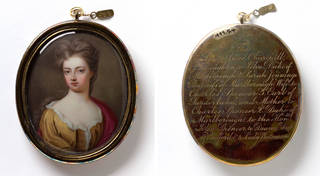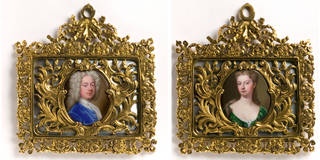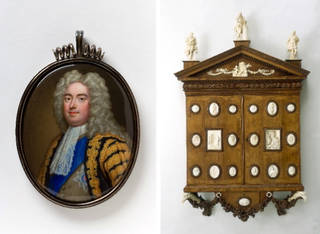The Gilbert Collection includes over seventy portrait miniatures painted in enamel, representing some of the most important artists working in the medium and a broad range of historically significant sitters.
Rosalinde and Arthur Gilbert first became interested in these works through their collection of gold boxes, some of which were set with enamel portrait miniatures. Arthur was impressed by their vibrancy and technical achievement, and often encouraged visitors to examine them through a magnifying glass, to appreciate the tiny details and the incredible skill that it took to create them.
Portrait miniatures painted in enamel on metal first appeared in Europe in the 1630s. Before this date portrait miniatures were painted in watercolour on vellum, their delicate surfaces protected in lockets or small boxes. The English word 'miniature' comes from the Italian word for 'illumination', miniatura, and portrait miniature painting in watercolour developed in the 1520s from the Medieval art of 'illuminating' or illustrating hand-written books. It was in the 17th century that the anglicised word 'miniature' came to mean something small – probably because of the small size of these paintings and a mistaken association with words beginning with the Latin root min indicating smallness, such as 'minor'.
Portrait miniature painting in watercolour had a long tradition in Europe from the 16th century to the 19th century. But from the 1630s, patrons had the additional choice of miniatures painted in enamel – a technique invented by Henri Toutin and made popular by Jean Petitot. Miniatures painted in enamel were attractive for their rich colour and also for their durability – unlike miniatures painted in watercolour, which were easily damaged by fading and damp.
Painting faces with fire
There are two types of support for portrait miniatures painted in enamel – enamel applied and fired onto porcelain, or onto a thin sheet of gold or copper. Most of the miniatures in the Gilbert Collection are enamel painted onto gold or copper.
To create enamel miniatures, powdered glass and metal oxides are mixed with oil to make a paste which is then painted colour by colour onto a metal or porcelain base. After the application of each layer of colour the miniature is fired in a kiln. The first layer would cover the entire support, including its reverse, to stop it from warping in the intense heat of the kiln. The colour which had the highest firing temperature – determined by the chemical makeup of the paint – would be applied first, and the remaining colours then applied in successive order. Before the invention of temperature controlled kilns, the different firing heats would be achieved by time: around 15 minutes for the highest temperature and as little as two minutes for the lowest. This meant that the creation of a painted enamel had to be meticulously planned, as each colour only had one chance to be fired.

Enamel miniatures were often copied from engravings or paintings, reproducing famous or favourite likenesses. Some experienced artists prided themselves on being able to paint directly from their subject, demonstrating their technical mastery. Some works signed 'ad vivum', meaning 'from life', confirmed this classification, but others, such as one by Jean Baptiste Weyler, have since been described as made 'from life' by art historians impressed with their lively style.
Metal supports can be fired at a higher temperature than porcelain which makes the final product more resilient and scratch-proof. Enamel miniatures were first painted on gold, as the technique derived from painted enamel scenes on gold watchcases. As the technique developed, copper became used more frequently as it was cheaper and could be fired at a higher temperature.

The larger the metal base, the greater the risk of the enamel warping and cracking. Henry Bone pioneered the large format miniature in the early 19th century. His 1825 image of George Washington bears the scars of this process: a large crack runs horizontally across the president's chest. However, Bone's patron, a Mr Williams, still admired the piece and allowed Bone to finish it. The reverse is inscribed with "Cracked in the 5th fire & finished by the permission of Mr. Williams from the Original picture".
Large-scale to small-scale
Large portraits painted in oil often formed part of the interior decoration of country houses, displayed on the walls. Portrait miniatures, by contrast, were small and portable and could even be worn as part of a bracelet or tied to clothing with ribbon.

Some enamel miniatures, however, took inspiration from large-scale oil paintings. The miniature of Georgiana, Duchess of Devonshire, dated 1779, took her portrait from a family depiction with her two siblings, which hung in her childhood home. This family portrait was painted in 1774, the same year that Georgiana married the 5th Duke of Devonshire. The artist, Angelica Kauffman, painted the three figures in a fashionable landscape setting.
In the enamel miniature of Georgiana copied from the group portrait five years later, only her elegant head and shoulders are presented, making the image more personal. A large-scale painting displayed on a wall has become a small-scale portrait, and the experience of looking at a formal painting of a group has become an intimate encounter between the viewer and the sitter.
Close connections
Painted enamel likenesses of loved ones were treasured possessions which celebrated personal connections. For the gentry and aristocracy they could also be an eloquent way to express their social status. The miniature of Anne Churchill is engraved with her familial connections – as the daughter of the 1st Duke of Marlborough, wife of the 3rd Earl of Sunderland and mother of the 2nd Duke of Marlborough. This enamel, set in its engraved case, has become a memorial to Anne and her important role in securing for her husband's family the Dukedom of Marlborough, transferred from her father to her son.

Miniatures were also used to remember lost family members. The 1806 enamel portrait of Captain John Whitby graces the cover of a locket, which holds a memorial poem and a lock of his hair.

Portraits as presents
Enamel miniature portraits were initially popular as diplomatic presents, given by rulers to their subjects, or to essential allies. From the 1660s, such presents were framed with diamonds, and called 'boite a portrait', French for 'box with a portrait', even though they have nothing to do with a box! As diamonds were frequently dismantled and sold, this example, with its original setting, is an extremely rare survivor. It depicts an Elector – a German prince entitled to take part in the most prestigious election of the Holy Roman Emperor – the largest empire in Western Europe at the time.

The potential for secrecy made miniatures the perfect gift for a lover, allowing them to keep their beloved physically close, but hidden, and to contemplate their face in private. Miniatures were also given to celebrate more legitimate unions and were popular as wedding gifts, particularly in the 18th century when wives often wore their husband's image as part of a bracelet or necklace. This pair of portraits of a newly wed couple would have originally been set in a pendant or bracelet so that they could have been worn. These later frames would have been added to make them more easy to display in a cabinet, or on a wall.

Famous faces
Many people also collected miniatures that depicted faces of famous – or even infamous – individuals. Horace Walpole, a renowned 18th-century collector, had a special cabinet made to house his miniatures. In it, alongside antique cameos and relics, he kept a collection of just under 100 miniatures, selected not only for their beauty, but often for the fame of their subject. Walpole's collection of famous faces acted as illustrious company for the portraits of himself and his family, including his father, prime minister Robert Walpole. They were also a way for Walpole to spend time with those historical figures who fascinated him as collector, in much the same way they fascinated the Gilberts.

Enamel portraits of famous sitters could be made by artists who lived at the same time as the sitter. This portrait of Louis XV was made around 1745 by John Adam Mathieu, head of painting for the then Vincennes porcelain factory, probably after contemporary official royal portraits.

In the Gilbert Collection
Rosalinde and Arthur Gilbert were both equally fascinated by the famous faces of history. They amassed miniatures in the same way and for the same reasons that generations of collectors had before them. As a visitor's eye swept over the miniatures, first in the Gilberts' Beverly Hills Villa and then displayed in a museum context they would appreciate not only the history of this art form and the famous faces captured by it, but also Rosalinde and Arthur's grasp of the subject. Bringing together characters from history, rendered by the best artists, their collection of enamel miniatures made both their knowledge and good taste visible.

